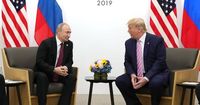In what was deemed an intensive round of negotiations, U.S. and Russian officials engaged in discussions over the ongoing conflict in Ukraine. These closed-door talks, held in Riyadh on March 24, 2025, lasted for 12 hours, yet the Kremlin has made it clear that the details will remain undisclosed.
Kremlin spokesperson Dmitry Peskov confirmed that, "The content of the technical negotiations will definitely not be published. This should not be expected". Additionally, he noted that the reports made by the Russian delegation to Moscow were under analysis, indicating that only after this process could any understanding be articulated.
Negotiations were expected to touch on a potential ceasefire in the Black Sea—an initiative reportedly rooted in discussions led by former President Donald Trump and agreed to by Russian President Vladimir Putin. According to Peskov, essential to these talks was a proposed pause in long-range attacks on critical infrastructure, which, despite an agreement in principle from both Putin and Ukrainian President Volodymyr Zelenskyy, has seen continued cross-border strikes.
As the U.S. and Ukrainian representatives were briefed on the discussions—and another round of talks commenced—Ukrainian forces prepared for further confrontations. Indeed, on the night of March 24 into March 25, Ukraine’s air force reported that Russia had launched one missile and 139 drones into its territory, with 78 drones successfully intercepted.
These complex diplomatic talks were characterized as "detailed and complex but quite useful" by Grigory Karasin, chairman of the Federation Council Committee on International Affairs, who participated in the Riyadh discussions. He elaborated that they discussed "numerous issues" which highlight the conflicting dynamics of the ongoing war.
Further complicating the situation, a joint statement regarding these negotiations was anticipated to be released the morning of March 25, at 4 a.m. EST or 11 a.m. in Moscow. However, that moment came and went without any word from American officials, leaving many speculating about the contents and future directions of the talks.
Many observers had hoped that this statement would clarify the nature of the discussions and the potential for a maritime ceasefire to allow shipments of grain, fuel, and other essential goods—a key topic given the devastating impact the conflict has had on supply chains. National Security Advisor Mike Waltz indicated that previous agreements regarding ceasefires on "aerial infrastructure" took effect as soon as Trump spoke with Putin, and the dialogue is now poised to proceed toward maritime issues.
The ongoing conflict remains fraught, with attacks still being carried out by both sides, underscoring the urgency for effective negotiation and the dire need for resolutions. On social media, President Zelenskyy asserted that "the war was brought from Russia and it is to Russia that the war must be pushed back"—highlighting Ukraine's goal of compelling Russia to return to a state of peace.
U.S. officials participating in the Riyadh discussions included the State Department’s Michael Anton and the National Security Council’s Andrew Peek. They are working closely with their Russian counterparts, who have emphasized a commitment to ongoing discussions despite the complexities involved. As the talks continue, attention remains firmly on the necessity of involving the United Nations and other international bodies.
Meanwhile, Russian officials are viewing the ongoing dialogues as particularly crucial, with negotiations likely to delve further into the multifaceted problems at play—ranging from immediate tactical discussions to broader strategic considerations of lasting peace. A statement from a Russian negotiator indicated Moscow's intent to keep up "useful" communication with the U.S., aiming to involve international partners as well.
In the midst of this backdrop, expectations are tempered yet carefully optimistic as delineations surface from the negotiations. Stakeholders from both sides await clarity on the agreements reached and next steps, all while the clock ticks ominously during this period of heightened military activity.
The world watches closely, as developments in these talks could redefine the trajectory of a conflict that has already seen unimaginable loss and suffering. It remains to be seen how the interplay of diplomacy and military action will evolve in the days ahead as the pressure mounts for both sides to find a resolution that may avert more significant conflict and restore stability in the region.





